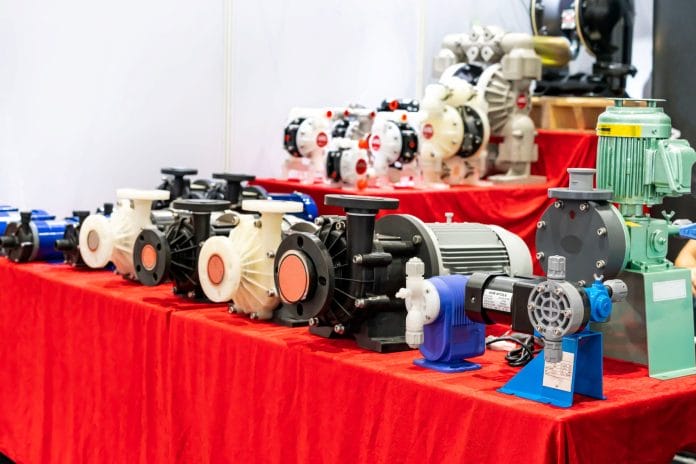When it comes to moving liquids, diaphragm pumps are some of the most versatile tools in the industry. These pumps offer reliability, efficiency, and adaptability, whether you’re dealing with chemicals, food products, or wastewater.
But what makes a diaphragm pump stand out, and why are they so widely used? In this guide, you’ll discover the essential details about diaphragm pumps, their applications, and their many advantages, helping you understand why they might be the perfect solution for your needs.
Key Variations and Features
Not all diaphragm pumps are created equal. Understanding their key variations and features can help you make the best choice for your needs.
Single Diaphragm Pumps
Single diaphragm pumps operate using one flexible diaphragm to move fluids. These tools are common in applications where lower flow rates or less pulsation control are acceptable, such as in small-scale chemical dosing or light-duty water transfer.
Double Diaphragm Pumps
As its name implies, a double diaphragm pump has two diaphragms working in tandem to provide a smoother flow and reduce pulsation. Air-operate double diaphragm or AODD pumps are common in industries requiring precision and reliability, such as pharmaceuticals and cosmetics.
Material and Design Options
Modern diaphragm pumps come in various materials, including stainless steel, plastic, and aluminium. Food and pharmaceutical industries prefer stainless steel for its durability and ease of cleaning. Many premier specialist suppliers can customise pump design, size, and configuration that suit your unique requirements. Contact a reliable company or visit their site, for instance, knf.com/en/uk, to find out more.
The ability to choose from a wide variety of designs, materials, and specifications ensures that diaphragm pumps can meet the demands of any business. Selecting the right combination of features helps you make the most out of your investment.
Applications of Diaphragm Pumps
You’ll find diaphragm pumps hard at work in many sectors. Their design and operation make them suitable for a wide variety of applications:
Chemical Processing
These pumps are commonly used in chemical plants to transport acids, solvents, and other aggressive substances. Their resistance to corrosion and ability to handle hazardous materials safely makes them ideal for this role. Many are ‘Atmosphére Explosible’ or ATEX-rated units, ensuring they meet safety standards in potentially explosive environments.
Food and Beverage Industry
Diaphragm pumps are essential in the hygienic market because of their ability to meet strict cleanliness requirements. Their stainless-steel components and compliance with European Hygienic Engineering and Design Group (EHEDG) sanitary specifications make them ideal for handling sauces, dairy products, and beverages.
Water Treatment
From wastewater management to treating drinking water, diaphragm pumps play a crucial role in filtration systems and chemical dosing. Their durability and low maintenance requirements make them a cost-effective choice for municipal and industrial applications.
Pharmaceuticals and Cosmetics
Precision is vital in these industries, and diaphragm pumps deliver. With adjustable flow rates and a design that prevents contamination, they ensure that creams, gels, and medicines are transported without compromising quality.
The diverse applications of diaphragm pumps highlight their unparalleled adaptability and reliability. Various studies are ongoing to further improve the design, material composition, and functionalities of these tools.
Advantages of Diaphragm Pumps
Now that you know their current uses across several industries, let’s explore why diaphragm pumps are so popular.
Versatility
Diaphragm pumps can handle almost any liquid type, from abrasive slurries to delicate food products. Their adaptability can handle applications requiring low and high flow rates. As such, they’re suitable for small-scale operations and large industrial setups.
Durability and Low Maintenance
With fewer moving parts compared to other industrial pumps, diaphragm pumps experience less wear and tear. This results in lower maintenance costs and longer operational life. Using double diaphragm pumps adds an extra layer of reliability.
Energy Efficiency
Many diaphragm pumps, including AOD pumps (air-operated diaphragm pumps), use compressed air as their power source. This eliminates the need for electrical components and reduces energy costs, especially in remote or hazardous environments.
Safety Features
Diaphragm pumps must meet stringent safety and sanitation standards. On top of the food and beverage sectors, compliant units also find their way into chemical plants, mining, and oil and gas operations. These settings are more hazardous than others as they process potentially explosive chemicals and substances.
Readily Available
Most suppliers keep large stocks of diaphragm pumps to ensure quick delivery. Having access to readily available inventory is a huge advantage whether you need stock sanitary pumps for food applications or pumps designed for corrosive chemicals.
The advantages of diaphragm pumps go far beyond their ability to handle liquids. Their energy efficiency, low maintenance needs, flexibility, and compliance with safety and hygiene make them a practical choice for any operation.
Choosing the Right Diaphragm Pump
When selecting a diaphragm pump, consider the following:
- Application Needs: Are you moving thick, viscous liquids or thin solutions?
- Material Compatibility: Ensure the pump material can withstand the chemicals or products you’re handling.
- Flow Rates and Pressure: Match the pump’s capabilities with your operational requirements.
- Compliance Standards: For industries like food or pharmaceuticals, look for pumps meeting EHEDG sanitary specifications or similar standards.
Making the right choice is key to unlocking smoother, more effective processes. Prioritising these considerations over the price tag can help you find the model that’s ideal for your operations.
Conclusion
Diaphragm pumps are a versatile and reliable solution for moving liquids across various industries. These pumps prove invaluable in countless applications. The key is to evaluate each option carefully.
Take the time to assess your needs before exploring traditional models and the possibilities for customisation. Weigh the pros and cons to find the right one. Hopefully, this guide has helped you take the first step in making an informed decision.



 Bitcoin
Bitcoin  Ethereum
Ethereum  Tether
Tether  XRP
XRP  Solana
Solana  USDC
USDC  Cardano
Cardano  TRON
TRON  Lido Staked Ether
Lido Staked Ether  Avalanche
Avalanche  Toncoin
Toncoin